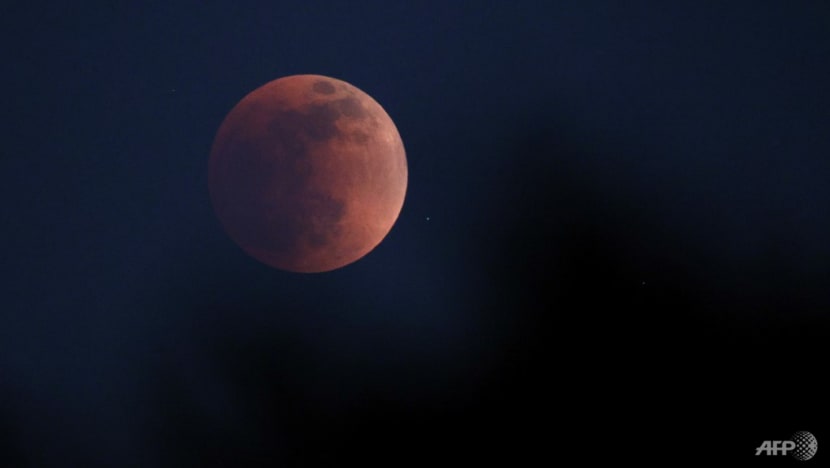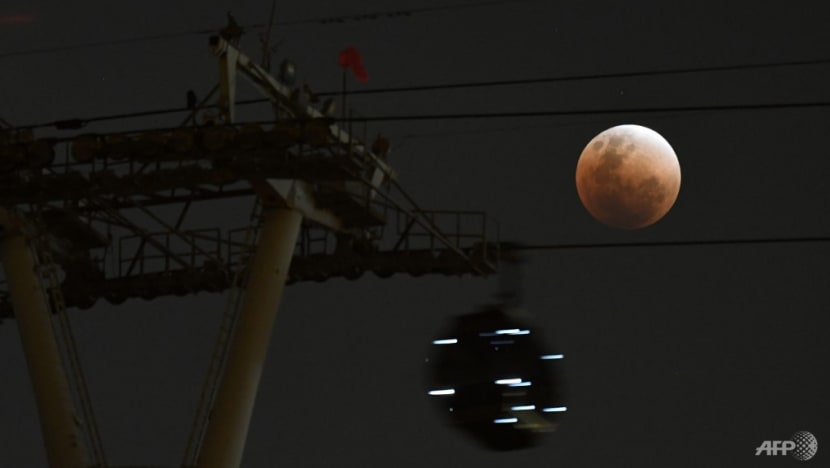Possible sighting of rare blood moon over Singapore on Nov 8
The next two total lunar eclipses will only happen in 2025.

A total lunar eclipse creates a "super blood moon" on May 15, 2022 in Huntington Beach, California. (File photo: AFP/Getty Images/Michael Heiman)
SINGAPORE: Skygazers in Singapore may be able to catch a glimpse of a rare blood moon next month, the result of a total lunar eclipse.
The celestial sighting will take place on Nov 8 but it may be challenging to observe the phenomena.
The Science Centre Observatory said in a Facebook post on Monday (Oct 10) that the total lunar eclipse will begin with a penumbral eclipse at 4.02pm.
This will then be followed by a partial eclipse at 5.09pm before a full eclipse at 6.16pm. However, these stages will not be visible as the moon will only rise at 6.46pm, said the observatory.
By then, the rising moon will appear dark and will only rise to an "appreciable altitude" of about 30 degrees by 9pm.
While the Science Centre Singapore will not be organising an event to observe the eclipse, the observatory said that interested viewers could attempt to view blood moon by themselves.
Members of the public are advised to head for somewhere with a clear view of the Eastern horizon, which is the opposite of where the sun sets, from 7pm onwards.
Although equipment is not necessary, viewers may wish to use a pair of binoculars. The moon will likely appear red due to the eclipse and Singapore's atmospheric conditions, said the observatory.
The full eclipse phase is predicted to end at 7.41pm, followed by the partial eclipse phase ending at 8.49pm and finally the penumbral eclipse ending at 9.56pm.
The upcoming total lunar eclipse on Nov 8 will be visible in the regions of Asia, Australia, the Americas and the Pacific.
The previous total lunar eclipse was on May 16 this year, which was visible in the Americas, Europe and Africa. The phenomena lasted for more than an hour, according to National Aeronautics and Space Administration (NASA) data.
The next two total lunar eclipses will only happen in 2025.
WHAT MAKES THE BLOOD MOON RED?
According to NASA, lunar eclipses occur at the full moon phase when the Earth is positioned precisely between the moon and the sun.
The Earth's shadow falls upon the surface of the moon, dimming it and sometimes turning the lunar surface red over the course of a few hours. Each lunar eclipse is visible from half of Earth, added NASA.
There are three different types of lunar eclipses - penumbral eclipses, partial lunar eclipses and total lunar eclipses.
Total lunar eclipses are rare. They happen when the moon moves into the inner part of Earth's shadow, which is also known as the umbra. Some of the sunlight passing through the Earth's atmosphere reaches the moon's surface, lighting it dimly.

During a total lunar eclipse, the moon appears orange or reddish. NASA said this is because colours with shorter wavelengths, like the blues and the violets, scatter more easily than colours with longer wavelengths, such as red and orange.
These are the wavelengths that make it through the Earth's atmosphere, thus giving the moon its "blood-like" appearance. The more dust or clouds in Earth’s atmosphere during the eclipse, the redder the moon appears.
Unlike a solar eclipse, it is safe to look at a lunar eclipse with the naked eye.
The next total lunar eclipse will only happen on Mar 14, 2025 and will only be visible in the Americas, Europe and Africa.
However, another total lunar eclipse will happen again on Sep 7, 2025. This time, it will be visible in Europe, Africa, Asia and Australia.














